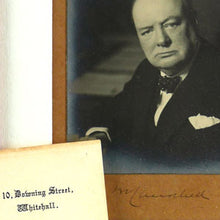WREN Cypher Officer’s Signed Churchill Portrait Photograph, 1945
Adding product to your cart
Image: 9.2cm (3.6in) x 7.2cm (2.8in)
Provenance: Presented by Churchill to Third Officer Jane Eldridge, WRNS, Cypher Officer, at the Quebec and Cairo Conferences of 1943.
Original gelatin silver print. Half-length portrait of the Prime Minister at the Cabinet table by Walter Stoneman, made during the photographic session at 10 Downing Street in the early afternoon of 19 April 1941. Signed in the mount to the lower right in ink in Churchill’s hand ‘W Churchill’, and complete with a letter of presentation to Jane Eldridge on 10 Downing Street head notepaper dated 26th July 1945. Framed and glazed. Overall size: 21.6cm (8.5in) x 18.5cm (7.2in).
Read more
Stoneman’s photographic session of April 1941 produced not only this image, which was given in the present size to selected members of the wartime prime minister’s staff, but also the portrait that was reputedly kept on Stalin's desk in the Kremlin following Hitler’s betrayal of the Soviet-Nazi Pact just two months later in June 1941. During Stoneman’s visit to Downing Street, Churchill was awaiting word of Germany’s invasion of Yugoslavia. Decrypted German Enigma messages had not only enabled him to predict Germany’s Balkan plans, they had revealed to him Germany’s ‘magnitude of design,’ as he termed it, against its ally, Russia. As a result, Churchill made the dangerous decision to send a personal message of warning to Joseph Stalin. It was a message that Stalin chose to ignore. The seated portrait remained one of Churchill’s favourite images (see National Portrait Gallery NPG x6138)

Jane Eldridge was commissioned in the WRNS in 1943 from the Royal Naval College, Greenwich. and trained as a Cypher Officer. Within a few weeks she was embarked in the transatlantic liner Queen Mary with a party of Wren Cypher Officers and Coders assigned to the First Quebec Conference, codenamed Quadrant - the highly secret meeting held at the Citadelle and the Château Frontenac between Winston Churchill and Franklin D. Roosevelt, hosted by the Canadian prime minister William Lyon Mackenzie King. The conference discussions included early stage planning for Operation Overlord and joint British, Canadian and American development of the atomic bomb. Cypher Officers and Coders were one of the few WRNS branches that entailed women serving at sea. Eldridge later accompanied Churchill aboard the battleship HMS Renown to Alexandria for the Cairo summit with FDR and Chairman Chiang Kai-shek. She and other Wrens were however not allowed to appear on deck for fear of alerting the enemy to their special role. Codenamed Sextant, it outlined the Allied position against the Imperial Japan and made decisions about post-war Asia. Eldridge worked cyphering and decyphering messages at Middle East headquarters for the duration of the conference.

Jane (first left) with fellow Officers in Quebec
Walter Stoneman, MBE (1876-1958) began his career as a junior photographer with the well established firm of J. Russell of Baker Street, London. In 1897 he was the only one of Russell’s photographers that managed to obtain images of Queen Victoria in the state landau during the Diamond Jubilee. By 1913 he had risen to the position of Managing Director. In 1917 he approached the Director of the National Portrait Gallery, James Milner, with an ambitious idea for a National Photographic Record. The Record was set up to photograph every eminent British person, with a photograph of each to be kept as a permanent record in the Gallery's reference collection. Stoneman photographed some 7,000 sitters on the Gallery's behalf; he worked on the Record for forty-one years, adding a hundred portraits each year.






